[ENG/ESP] Ubuntu derivatives, an open source universe that has been maintained over the years. / Las derivadas de Ubuntu, un universo open source que se mantiene a través de los años.

As I already explained in this post #hivers friends, a few days ago Ubuntu released a new version of its distro, it is the 22. 04 (22 is the year of release and 04 is the month in which the first version is released, the second is in October and bears the number 10) to which Canonical and its founder Mark Shuttleworth have given the code name "Jammy Jellyfish" which translated into English would give something like Jellyfish with Jam.
It's hard to combine an animal name with an adjective, both with the same letter, but there's the fun.
But if there is something that has characterized Ubuntu since the beginning is the large number of official derivatives that are based on Ubuntu and that work with a desktop environment, that is, a different desktop environment, which in general adapts to different needs and tastes. And it is precisely, speaking of tastes, that in English these distributions derived from Ubuntu are known as "Ubuntu flavours", and in Spanish, the translation is literally "flavors of Ubuntu".
Always with the mathematical precision that accompanies Ubuntu every time a new version is released (only once it was late back in 2006, when instead of releasing the version in April it was released in June and for that reason Dapper Drake -the name chosen at that time- is called 2006.06 (when it should have been 2006.04).
A precision that draws a lot of attention, but that also identifies the commitment and the will shown by Canonical over the years to maintain an absolutely free distribution that, in many aspects, has nothing to envy to Microsoft-Windows. And that, with a few exceptions, uses free and open source software, much of which is developed by a large number of independent programmers who do not receive any retribution except the occasional donation.
Now then: how is this "multicolor" universe of Ubuntu and its derivatives constituted? (I use this term because I like it better than "flavors")
The screenshots all coming from the respective official web pages refer to the last released version 22.04 "Jammy Jellyfish".

Como ya les explicaba en este post amigos #hivers, hace pocos días Ubuntu publicó una nueva versión de su distro, es la 22.04 (22 es el año de publicación y 04 el mes en que puntualmente se publica la primera versión, la segunda es en octubre y lleva el número 10) a la cuál Canonical y su fundador Mark Shuttleworth le han dado el nombre en código de "Jammy Jellyfish" que traducido al español daría algo así como Medusa con Mermelada.
Es difícil combinar un nombre de animal con un adjetivo, ambos con la misma letra, pero ahí está la diversión.
Pero si hay algo que ha caracterizado a Ubuntu desde el inicio es la gran cantidad de derivadas oficiales que se apoyan en Ubuntu y que funcionan con un desktop environment, es decir, un entorno de escritorio, distinto, que en general se adapta a diversas necesidades y gustos. Y es precisamente, hablando de gustos, que en inglés se conoce estas distribuciones derivadas de Ubuntu como "Ubuntu flavours", y en español, la traducción es literal "sabores de Ubuntu".
Siempre con la precisión matemática que acompaña a Ubuntu cada vez que es publicada una nueva versión (una sola vez se atrasó allá por el 2006, cuando en vez de publicar la versión en abril lo hizo en junio y por ese motivo Dapper Drake -el nombre elegido en ese momento- se llama 2006.06 (cuando debería haber sido 2006.04)
Una precisión que llama enormemente la atención, pero que además identifica el empeño y la voluntad puestos de manifiesto por Canonical a través de los años en mantener una distribución absolutamente gratuita que, en muchos aspectos, no tiene nada que envidiar a Microsoft-Windows. Y que, salvo algunas excepciones, usa software libre y de código abierto, mucho del cuál desarrollado por una gran cantidad de programadores independientes que no reciben retribución alguna salvo alguna que otra donación.
Ahora bien: como está constituido este universo "multicolor" de Ubuntu y sus derivadas? (uso este término porque me gusta más que el de "sabores")
Las capturas de pantallas todas provenientes de las respectivas páginas web oficiales se refieren a la última versión publicada 22.04 “Jammy Jellyfish"
Kubuntu.
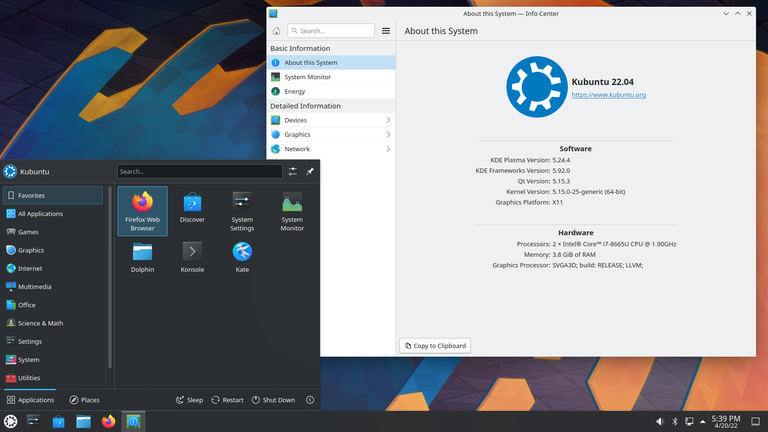
Among the many merits of Linux for simplifying with open source software (it is noteworthy that all these Linux distros have only the kernel and then are customized by each developer) is to allow and have created a large number of desktop environments to provide a graphical interface to each distribution and give it a characteristic of its own.
Which is not just a matter of style. It also has to do with the resources it consumes on the PC. For this reason some go well with last generation PCs and others on the other hand have been created for computers with low resources.
Kubuntu from the beginning was synonymous with elegance that relied on the KDE desktop environment with the Plasma theme. Later Plasma was integrated with the environment and it was renamed KDE Plasma. It is currently in its fifth version.
It was originally adopted by Ubuntu who added the letter K in front to identify it with KDE. Thus was born Kubuntu, i.e. the Ubuntu distro with KDE as desktop environment. It includes a new default theme, called Breeze, uses OpenGL a library needed to write 2D and 3D applications and has incorporated the QML language used for mobile applications.
I will talk in detail about this derivative later. But for now - in broad strokes - I just want to introduce each one.

Entre los tantos méritos de Linux por simplificar con el software open source (es de destacar que todas estas distros de Linux llevan solo el kernel y después son personalizadas por cada desarrollador) es el de permitir y haber creado un gran número de entornos de escritorio para proporcionar una interfaz gráfica a cada distribución y darle una característica propia.
Que no es solamente cuestión de estilo. Tiene que ver también con los recursos que consume en el PC. Por este motivo algunas van bien con PC de última generación y otras, en cambio, han sido generadas para ordenadores de bajos recursos.
Kubuntu desde el inicio fue sinónimo de elegancia que se apoyaba en el ambiente de escritorio KDE con el tema Plasma. Posteriormente, Plasma se integró con el ambiente y este pasó a llamarse KDE Plasma. Actualmente, va por la quinta versión.
Originariamente, fue adoptado por Ubuntu, quien le agregó la letra K adelante para identificarlo con KDE. Así nació Kubuntu, es decir la distro Ubuntu con KDE como entorno de escritorio. Incluye un nuevo tema por defecto, llamado Breeze, usa OpenGL una librería necesaria para escribir aplicaciones en 2D y 3D y ha incorporado el lenguaje QML que se usa para las aplicaciones destinadas a los móviles.
Más adelante hablaré en detalle de esta derivada. Pero por ahora -a grandes rasgos- solo quiero presentar cada una.
Lubuntu.
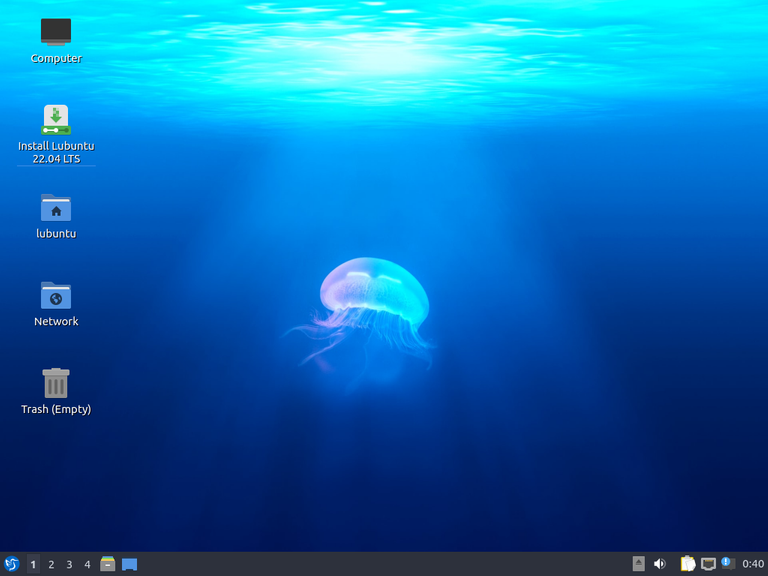
Lubuntu is a derivative of Ubuntu that uses the LXDE desktop environment and free software released under the terms of the GNU General Public License.
It is especially recommended for PCs that are a few years old and have limited resources.
Starting from version 18.10 (i.e. four years ago) a LXQt as default environment.
It provides a lightweight, hardware-friendly and energy-saving system designed to be light, easy and fast.
XDE works well on both old and new computers, and ensures a smooth desktop experience, but it is clearly aimed at early adopters who are unable to support graphically intensive environments.
There was an important migration of Ubuntu users to Lubuntu when the first one adopted Unity as default environment, which aesthetically reminded us all the beauty of the Mac but was too heavy for the old PCs, often crashing.
Lubuntu is a derivative of Ubuntu that uses the LXDE desktop environment and free software released under the terms of the GNU General Public License.
It is especially recommended for PCs that are a few years old and have limited resources.
Starting from version 18.10 (i.e. four years ago) a LXQt as default environment.
It provides a lightweight, hardware-friendly and energy-saving system designed to be light, easy and fast.
XDE works well on both old and new computers, and ensures a smooth desktop experience, but it is clearly aimed at early adopters who are unable to support graphically intensive environments.
There was an important migration of Ubuntu users to Lubuntu when the first one adopted Unity as default environment, which aesthetically reminded us all the beauty of the Mac but was too heavy for the old PCs, often crashing.

Lubuntu es una derivada de Ubuntu que utiliza el entorno de escritorio LXDE y software libre publicado bajo los términos de la GNU General Public License.
Es especialmente recomendada por PC con algunos años de antigüedad y con recursos limitados.
A partir de la versión 18.10 (es decir, hace cuatro años) una LXQt como ambiente por defecto.
Proporciona un sistema ligero, respetuoso con el hardware y que ahorra energía diseñada para ser ligero, fácil y rápido.
Xfce funciona bien tanto con ordenadores antiguos como con los nuevos, y garantiza una experiencia de escritorio fluida, pero es evidente que está enfocado hacia los primeros que no logran soportar ambientes demasiado gráficos gráficamente.
Hubo una importante migración de usuarios de Ubuntu hacia Lubuntu cuando el primero pasó a adoptar como ambiente predefinido a Unity que estéticamente nos hacía recordar toda la belleza del Mac, pero que pesaba demasiado para los viejos PC, bloqueándose a menudo.
Ubuntu MATE.
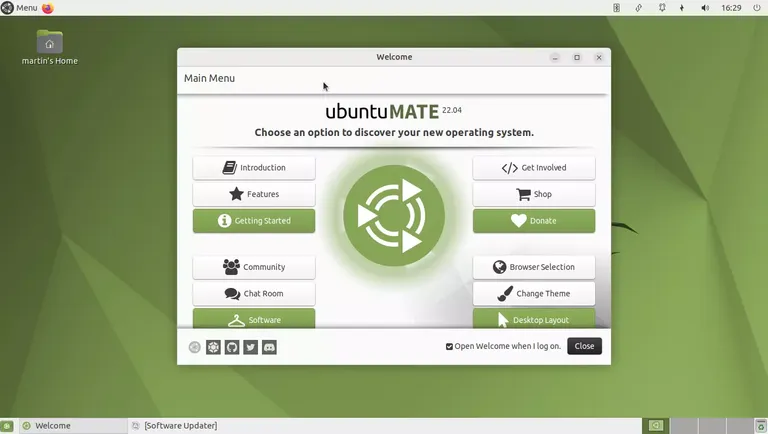
This derivative is named after the most popular drink in the Rio de La Plata (especially Argentina and Uruguay): mate and its logo is precisely a yerba mate leaf whose scientific name is Ilex paraguariensis.
Its beginnings see an Argentinean user of ArchLinux -another classic Linux distribution like Ubuntu- named Germán Perugorría who decides to carry out the project. In 2014 it is recognized as an official derivative and since that time it has been regularly incorporated into the remaining derivatives and their release schedule.
MATE is actually a GNOME2 derivative project that surely from the new version of Ubuntu that retakes it as a default environment will surely continue to capture users. Most of its applications have been inherited from GNOME2.
There are a lot of distributions, apart from Ubuntu, that support MATE and Arch Linux is one of them, apart from Linux Mint, Manjaro, OpenSUSE, Gentoo, Fedora, Debian and PCLinux among the most known.
This year was even the first to be published.

Esta derivada lleva el nombre de la bebida más popular en el Rio de La Plata (especialmente Argentina y Uruguay): el mate y su logo es precisamente una hoja de yerba mate cuyo nombre científico es Ilex paraguariensis.
Sus inicios ven a un usuario argentino de ArchLinux -otra distribución clásica de Linux como Ubuntu- llamado Germán Perugorría que decide llevar adelante el proyecto. En el 2014 es reconocida como derivada oficial y desde ese momento se ha incorporado con regularidad a las restantes derivadas y a su cronograma de publicación.
MATE en realidad es un proyecto derivado de GNOME2 que seguramente a partir de la nueva versión de Ubuntu que lo retoma como ambiente predefinido, seguramente seguirá capturando usuarios. La mayor parte de sus aplicaciones han sido heredadas de GNOME2
Hay una gran cantidad de distribuciones, aparte de Ubuntu, que soportan MATE y Arch Linux es una de ellas, aparte de Linux Mint, Manjaro, OpenSUSE, Gentoo, Fedora, Debian y PCLinux entre las más conocidas.
Este año incluso fue la primera en ser publicada.
Ubuntu Studio.
<center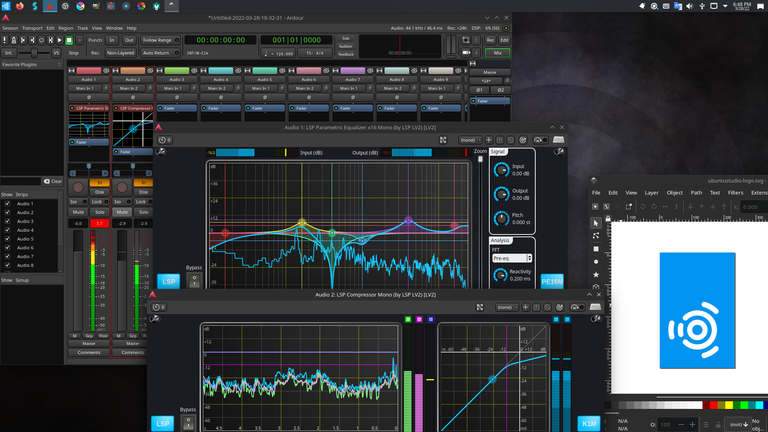 >
>
Ubuntu Studio was developed so that multimedia lovers, especially music and graphics lovers, would not be left out of Ubuntu. Ubuntu Studio has been designed to provide the user with a series of truly professional tools - despite being free and open source - such as Blender (the software used in the making of the movie Shrek, the nice ogre that was so successful a few years ago).
It was the first derivative to move away from the traditional Human theme used by Ubuntu in its first versions.
But the software battery does not end with Blender, a great software for the elaboration and editing of three-dimensional graphics, but we also have Kino and Stopmotion for example for film post-production and programs for audio editing as the classic Ardour.
The available software is divided into three categories: Audio, Video and Graphics.

Para que los amantes de la multimedialidad, especialmente de la música y de la gráfica, no quedaran afuera de Ubuntu fue desarrollado Ubuntu Studio, derivada que ha sido pensada poniendo a disposición del usuario una serie de herramientas verdaderamente profesionales -a pesar de ser de código libre y abierto- como por ejemplo Blender (el software usado en la realización de la película Shrek el simpático ogro que tanto éxito obtuvo unos años atrás).
Fue la primera derivada en alejarse del tradicional tema Human que utilizaba Ubuntu en sus primeras versiones.
Pero la batería de software no termina con Blender, un estupendo software para la elaboración y edicion de gráfica tridimensional, sino que también tenemos a Kino y Stopmotion por ejemplo para la postproducción cinematográfica y programas para la elaboración de audio como el clásico Ardour.
El software disponible se divide en tres categorías: Audio, Video y Gráfica.
Xubuntu.
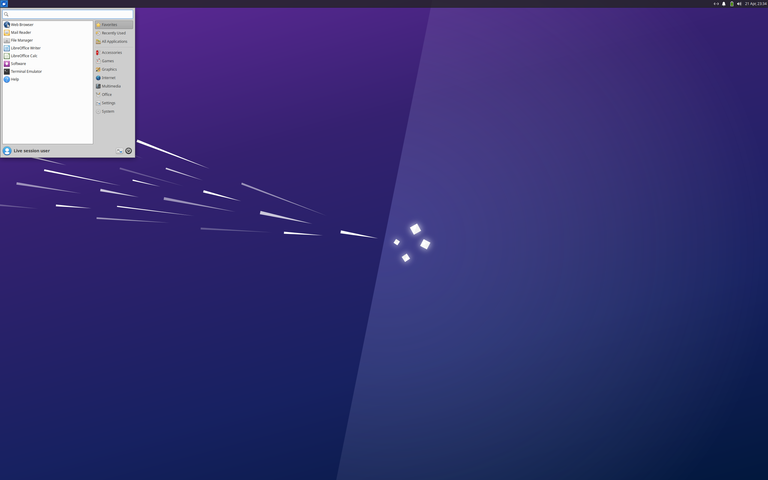
Xubuntu (the derivative I use and with which I write this post) is an intermediate line between Ubuntu and Lubuntu, that is to say especially recommended for those PCs that are not too old but not too modern either.
The environment it uses is Xfce created in 1996 for various Unix-like systems including FreeBSD and GNU/Linux and despite consuming a relatively low amount of resources it looks nice and is quite fast and customizable.
In the latest version an Editor widget has been created that can be easily integrated into Xfce applications.
Recently several non-Ubuntu distributions have started to support Xfce, including LinuxMint, Manjaro, Zenwalk and PeppermintOS among the best known.

Xubuntu (la derivada que empleo y con la cuál escribo este post) es una línea intermedia entre Ubuntu y Lubuntu, es decir especialmente recomendada para aquellos PC que no son demasiado viejos pero tampoco demasiado modernos.
El ambiente que emplea es Xfce creado en el año 1996 para varios sistemas Unix-like entre ellos FreeBSD y GNU/Linux y a pesar de consumir una cantidad relativamente baja de recursos tienen un aspecto agradable y es bastante rápido y personalizable.
En la última versión ha sido generado un widget del Editor que puede ser fácilmente integrado en las aplicaciones de Xfce.
Últimamente, han sido varias las distribuciones ajenas a Ubuntu que han comenzado a soportar Xfce, entre ellas LinuxMint, Manjaro, Zenwalk y PeppermintOS entre las más conocidas.
Ubuntu Kylin.
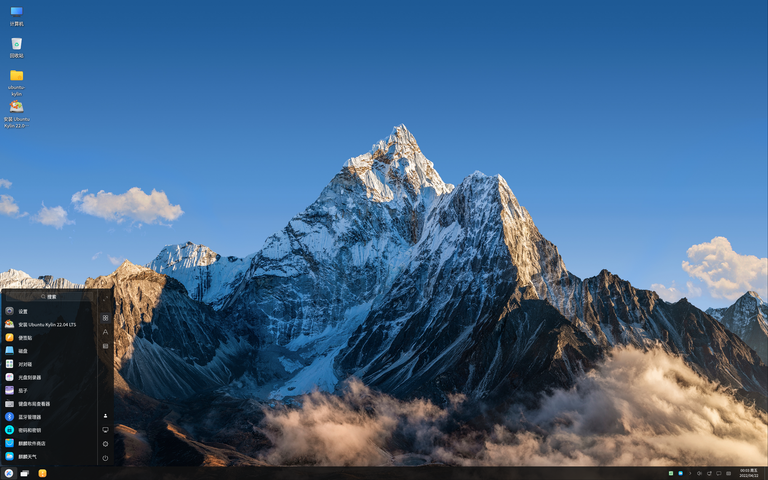
I leave for the last this distro reserved for the Chinese market, created in 2013, with the aim of introducing free software in that country.
Apparently Canonical has achieved its goal because the derivative continues to be released regularly along with the rest.
So far, a brief overview of the Ubuntu derivative universe. Later, in other posts, I will go into more detail about each one.
See you next time!

Dejo para lo último esta distro reservado al mercado chino, originada en el año 2013, con el objetivo de introducir el software libre en ese país.
Aparentemente Canonical ha logrado su objetivo porque la derivada sigue publicándose con regularidad junto al resto.
Hasta aquí un breve panorama sobre el universo de las derivadas Ubuntu. Más adelante, en otros posts, me explayaré con mayor detenimiento sobre cada una.
¡Hasta la próxima!

The lower part of the signature banner corresponds to the badget made by the @hivebuzz team. My thanks to them and in particular to @arcange.
La parte inferior del banner de la firma corresponde al badget elaborado por el equipo de @hivebuzz. Mi agradecimiento a ellos y en particular a @arcange.
https://twitter.com/HugoRep/status/1519762379701161984
The rewards earned on this comment will go directly to the person sharing the post on Twitter as long as they are registered with @poshtoken. Sign up at https://hiveposh.com.
Thanks @poshtoken.
Ohh no conocía varias de esas distribuciones, gracias por presentarlas. Te recomendaría subir este tipo de contenido en la comunidad DevelopSpanish o en GeekZone para lograr mayor alcance. Saludos y mucho éxito :D